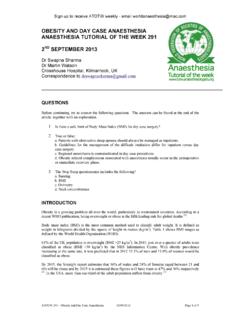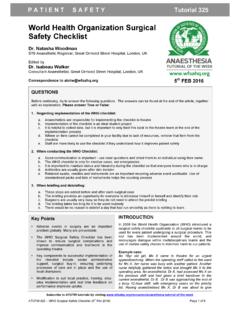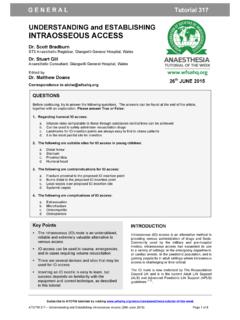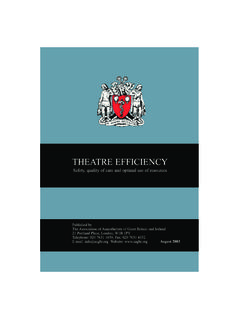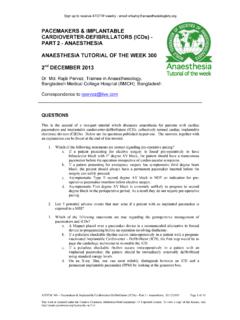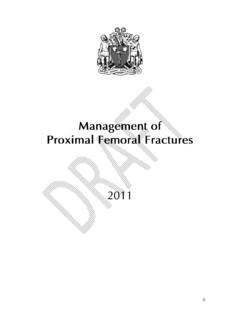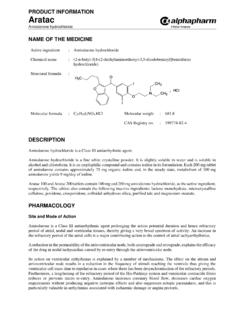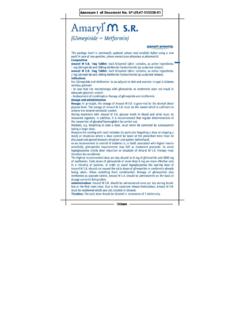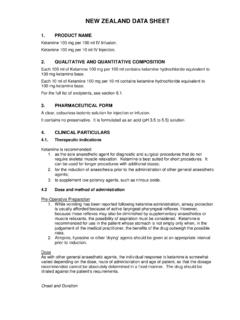Transcription of 307 Atrial Fibrillation (AF). Peri-operative …
1 Sign up to receive ATOTW weekly - email ATOTW 307 Atrial Fibrilation (AF). Peri-operative Management for Non-cardiac surgery 28/04/2014 Page 1 of 9 Atrial Fibrillation (AF). Peri-operative MANAGEMENT FOR NON-CARDIAC surgery ANAESTHESIA TUTORIAL OF THE WEEK 307 28th APRIL 2014 Dr J Sokhi Southend University Hospital, UK Professor J Kinnear Southend Unviersity Hositpal, UK Correspondence to: QUESTIONS Try to select the correct answers from the following statements. The answers can be found at the end of the article, together with explanations. 1. Atrial Fibrillation : a. The incidence increases with age b. On an ECG is identified by the absence of p waves and a regularly irregular rhythm. c. A CHADS2 score of greater than 3 suggests a high risk of thromboembolic complications d.
2 All patients in AF require treatment with warfarin e. The a- wave on the JVP is more prominent in patients with AF 2. Atrial Fibrillation treatment options: a. -blockers are first choice agent for all patients with AF b. Digoxin is a useful agent for acute rhythm control c. Amiodarone is first line agent in haemodynamically unstable AF d. Nifedipine is an effective treatment option in AF e. After elective cardioversion and restoration of sinus rhythm, warfarin can be stopped immediately afterwards 3. The following may precipitate AF: a. Hypokalaemia b. Hyperkalaemia c. Hypomagnesia d. Hypovolaemia e. Sepsis Sign up to receive ATOTW weekly - email ATOTW 307 Atrial Fibrilation (AF). Peri-operative Management for Non-cardiac surgery 28/04/2014 Page 2 of 9 INTRODUCTION Atrial Fibrillation (AF) is the commonest arrhythmia.
3 It is associated with increasing age and results in significant morbidity. The management of AF is not straightforward and requires consideration of several aspects including the recognition of precipitating factors, appropriate anticoagulation, and choosing a suitable method to either restore sinus rhythm or achieve rate control. This article aims to cover the key points regarding management of AF during the perioperative period. The estimated prevalence of AF is 1-2%, and is increasing in developed countries as the population ages. It is difficult to estimate the perioperative incidence of AF, but it has been reported to be as high as 30% after coronary artery bypass graft (CABG) surgery . It is associated with significant morbidity and mortality, which includes an increased risk of heart failure, stroke and prolonged hospitalisation.
4 Medical management is centred round three core strategies: 1. Assessment of the thromboembolic risk by using appropriate risk stratification scores and implementing anticoagulation if deemed necessary 2. Restoration of sinus rhythm or rate/symptom control 3. Treatment of the precipitating factors Surgical patients can present in AF in a variety of ways and a useful way of classifying it in this population is: Pre-existing AF New onset AF Paroxysmal Atrial Fibrillation (PAF) From a management perspective these various presentations of AF can be further classified according to whether they occur pre-operatively, intra-operatively or post-operatively. PRE-EXISTING Atrial Fibrillation Pre- operative management According to the National Institute for Health and Care Excellence (NICE) guidelines on pre- operative investigation, an ECG should be considered for patients over the age of 40 who are assessed as ASA II or above, and is recommended for patients with a history of cardiovascular disease.
5 A resting ECG will reveal AF by the absence of P waves and QRS complexes that occur in an irregularly irregular rhythm (figure 1). For patients with known AF, a transthoracic echocardiogram (TTE) is useful to ascertain the ejection fraction, exclude valvular heart disease (especially aortic or mitral valve involvement), and to look for regional wall motion abnormalities (RWMA). Sign up to receive ATOTW weekly - email ATOTW 307 Atrial Fibrilation (AF). Peri-operative Management for Non-cardiac surgery 28/04/2014 Page 3 of 9 Figure 1: A 12 Lead ECG showing narrow QRS complexes which are irregularly irregular and are not preceded by P waves. Patients with persistent or permanent AF should have their heart rate adequately controlled prior to an elective operation.
6 This is often achieved by beta blockade or centrally acting calcium channel antagonists (CCB). The benefits of beta blockade are well documented, and include reduction in myocardial infarctions and the development of new AF. However recent evidence has shown there may be an increased mortality and risk of stroke in patients taking beta blockers, so cessation of medication should be based on individual cases prior to surgery . Medications such as verapamil and diltiazem are often omitted on the day of surgery owing to their associated hypotension and profound bradycardia under anaesthesia, but there are no clear guidelines and decisions must be individualised. If the decision is made to continue current rate control medication, then patients should take their medication at their usual times despite nil by mouth restrictions.
7 The other important aspect to consider is anticoagulation. Scoring systems such as CHADS2, and the newer CHA2DS2-VASc (table 1), stratify patients based on the NICE guidelines, and the scores predict the patient s annual risk of stroke (table 2). Patients at low risk (CHADS2 score < 1) require no anticoagulation, while those at high risk (CHADS2 score of 2 or more) require warfarisation to a target INR of 2-3, or an equivalent level with new anticoagulants such as Dabigatran. Traditionally, patients with an intermediate score (CHADS2 of 1-2) were offered a choice between aspirin or warfarin, but aspirin has now been shown to be inferior to warfarin in stroke prevention. Therefore anyone with a score > 1 should probably also be warfarinised if there are no contraindications.
8 Prior to surgery it is important to ensure that anticoagulation is managed appropriately. The risk of thromboembolism in patients who discontinue anticoagulation for a short period ( 5 days) before an invasive procedure must be weighed against the risk of bleeding if these agents are continued. Therefore, the thrombotic and bleeding risks should be carefully assessed before deciding on how best to modify the anticoagulation. There is no good evidence that a short period of warfarin interruption is harmful for low to intermediate risk patients. For patients at very high risk for thrombosis (eg, CHADS2 4, CHA2DS2-VASc 5), consider the use of bridging anticoagulation with intravenous heparin, therapeutic dose low molecular weight (LMW) heparin (eg, enoxaparin 1 mg/kg subcutaneously twice daily), or an intermediate-dose bridging regimen (eg, enoxaparin 40 mg subcutaneously twice daily).
9 For patients undergoing low bleeding risk procedures ( lesion excisions), there is no need to alter their anticoagulation treatment, provided the INR is within the therapeutic range. A useful strategy would be to employ sub-therapeutic doses of LMW heparin in low and intermediate risk patients, which is a safe compromise between the risks of bleeding and thrombosis. Sign up to receive ATOTW weekly - email ATOTW 307 Atrial Fibrilation (AF). Peri-operative Management for Non-cardiac surgery 28/04/2014 Page 4 of 9 For patients at a high risk of procedural bleeding warfarin should be stopped five days preoperatively to achieve an INR If bridging anticoagulation is used then unfractionated heparin should be stopped 4-5 hours before surgery , and LMW heparin stopped 24 hours before surgery .
10 Therapeutic dose intravenous or LMW heparin should not be restarted postoperatively until at least 24 hours after surgery and delayed longer (48-72 hours) if there is major surgery , a high risk of bleeding, or if there is any evidence of on-going bleeding. When warfarin is restarted the INR should be in the therapeutic range for at least 48 hours before heparin is discontinued. Table 1: Risk stratification scores adapted from BMJ BAFTA trial. A score of one point is added for each risk factor. The CHA2DS2-VASc system incorporates additional risk factors. Scoring system Criteria Low risk Intermediate risk High risk CHADS2 C- Congestive cardiac failure of Echo H-Hypertension (160/90) A >75 years D- Diabetes Mellitus S (2) previous stroke/TIA 0 1 2 CHA2DS2-VASc As above, plus: Age 1 point if between 65-74, 2 points if >75 V- vascular disease- MI /PVD/ aortic disease- 1 point S- Sex- Female gender 1 point 0 1 2 Table 2.
